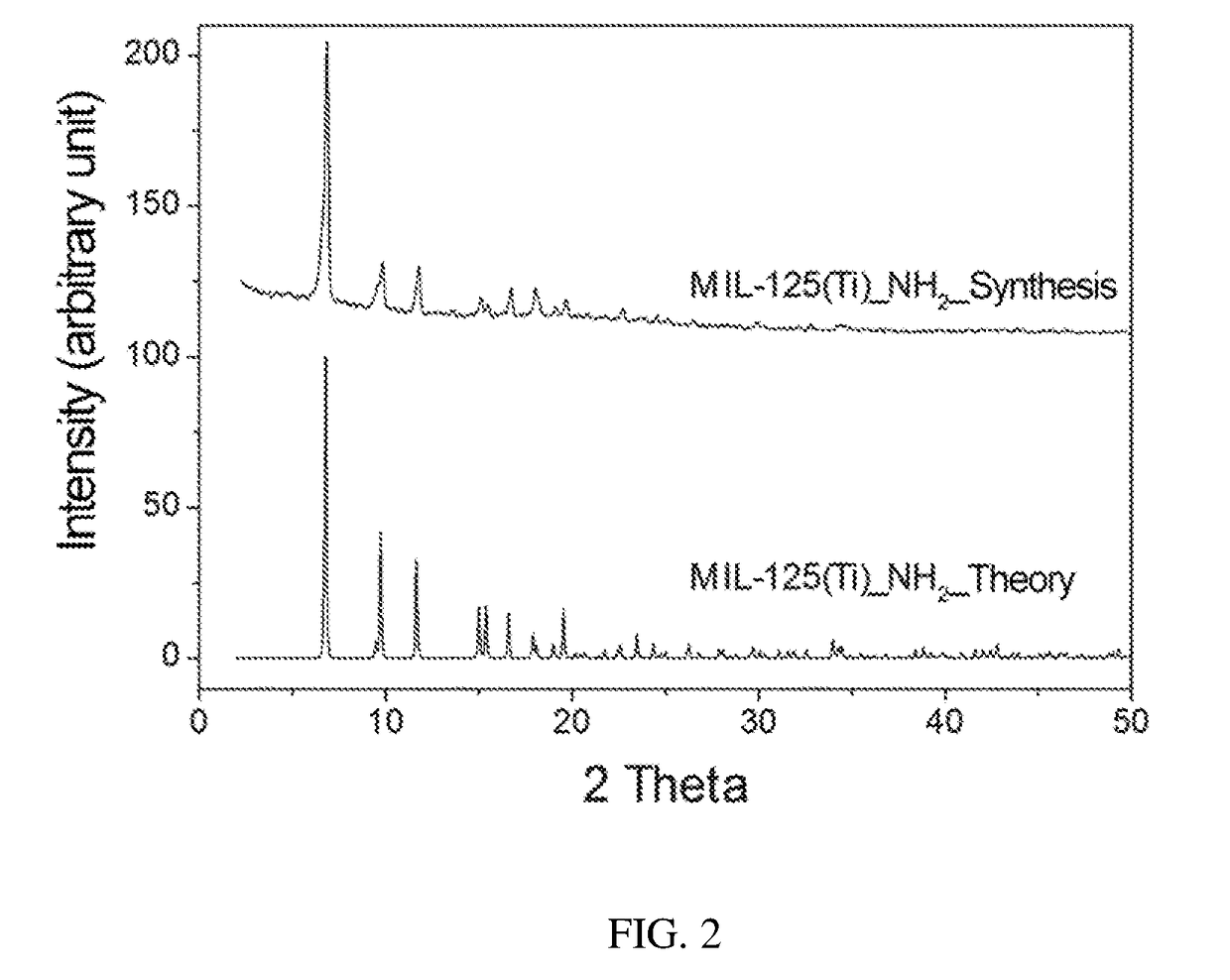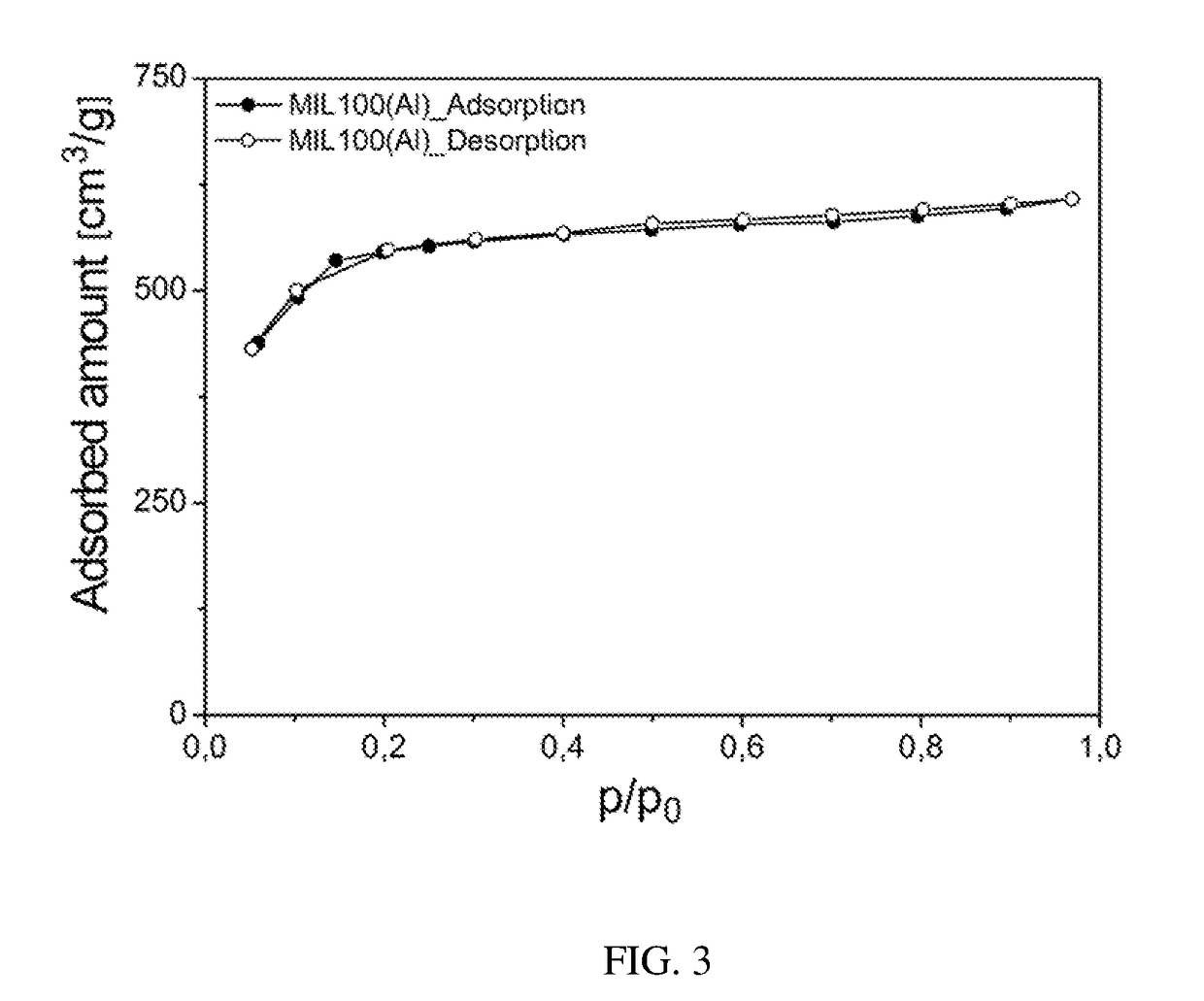Washing or cleaning agent for reducing malodors
- Summary
- Abstract
- Description
- Claims
- Application Information
AI Technical Summary
Benefits of technology
Problems solved by technology
Method used
Image
Examples
example 1
Synthesis of Metal Organic Framework (MOF) Compounds According to the Invention
Synthesis of NH2-MIL-125(Ti)
[0069]On the basis of the following literature: S.-N. Kim et al., Catalysis Today 2013, 204, 85-93
[0070]A solution of 3 mmol of titanium isopropoxide (Ti[OCH(CH3)2]4, Aldrich, 97%) and 6 mmol of 2-aminoterephthalic acid (H2BDC—NH2, Aldrich, 99%) in 50 mL of N,N-dimethyl formamide / methanol (1:1, v / v) was produced. Said solution was transferred to a 250-mL steel autoclave (DAB-3 from Berghof) having a PTFE insert. The autoclave was held at 150° C. for 16 h by means of a convection oven. After cool-down to room temperature, the yellow powder was filtered, washed twice with DMF, and then washed with ethanol.
[0071]The yield was 760 mg.
BRIEF DESCRIPTION OF THE DRAWINGS
[0072]FIG. 1 illustrates a nitrogen adsorption isotherm;
[0073]FIG. 2 is an x-ray powder diffractogram showing the reflections of NH2-MIL-125(Ti);
[0074]FIG. 3 shows a nitrogen adsorption isotherm without further activati...
example 2
Odor Test
[0097]The performance with regard to reduction of offensive odor was determined as follows. The MOF powders were suspended in a solvent (aqueous or non-aqueous, such as ethanol, deionized water, or washing-agent solution (produced by dissolving 4 g of a liquid washing agent in 1 L of water of 16° dH)) by means of an ultrasonic bath. Nonwovens (various materials, such as polypropylene (PP) or viscose) were uniformly wetted with suspension on a permeable base. The filter function of the nonwoven material causes immobilization of the MOF solid particles. A (2 cm×2 cm) nonwoven equipped with the particular MOF was placed in a screw-top glass jar of defined size. A defined amount of a sweat offensive-odor mixture was introduced into said jar. The jar was immediately closed. After a holding time of 5 min, the jar was opened and the odor intensity was determined olfactorily (scale of 0-10; 0=no offensive odor, 10=strong offensive odor). In addition to compounds according to the in...
example 3
Absorption
[0107]A softener having the following composition was produced:
wt %activeIngredientsubstanceDem. water90.1669MgCl*6 H2O0.0595Stepantex CHT 904.75DC AC 80660.0190Parmetol D110.0046MIL-100(Al)5.00
[0108]Then the absorption behavior of the MOF according to the invention on textiles was determined, on the basis of the softener specified above, in comparison with an aqueous solution consisting of the same MOF as in the softener specified above and water.
[0109]For this purpose, a 46-g cotton terry-cloth woven fabric was rinsed with 225 mL of liquid, containing 0.33 g of softener (for composition, see table above), in a launderometer for 30 minutes at 20° C. and then spin dried for 60 seconds (Thomas spin dryer, model 772 NEK286). After the drying, the aluminum content was determined.
[0110]As a comparison, the same amount of the same MOF was applied to the terry-cloth woven fabric in a forced manner by dripping application and subsequent drying.
[0111]To determine the adsorption be...
PUM
 Login to View More
Login to View More Abstract
Description
Claims
Application Information
 Login to View More
Login to View More - R&D
- Intellectual Property
- Life Sciences
- Materials
- Tech Scout
- Unparalleled Data Quality
- Higher Quality Content
- 60% Fewer Hallucinations
Browse by: Latest US Patents, China's latest patents, Technical Efficacy Thesaurus, Application Domain, Technology Topic, Popular Technical Reports.
© 2025 PatSnap. All rights reserved.Legal|Privacy policy|Modern Slavery Act Transparency Statement|Sitemap|About US| Contact US: help@patsnap.com



